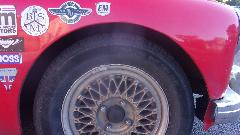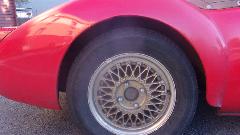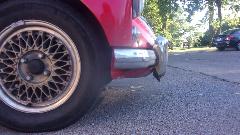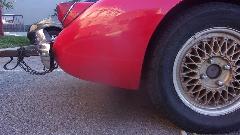The MGA With An Attitude
RIDE HEIGHT For The MGA -- FS-100
On 6/8/2020, Tony Horsington in Parkes, NSW, Australia wrote:
"I have been attempting to discover how one can determine if the rear springs have sagged over the past 60 years. Is there a measurement from say the top of the rear wheel arch to the ground - to determine if the car is traveling lower than it did when new"?
People keep asking about the proper ride height for the MGA. The primary concern seems to be possibly sagging springs that may need to be replaced. Oddly enough, the front coil springs and rear leaf springs are often still good for continued service, even when these parts are 60 years old. I suppose we are more likely to encounter broken springs than badly sagging springs. The pictures here are not the best to demonstrate the ride height. It is my car, it is sitting with the nose downhill (front end a little bit low), and it had the leaf springs replaced in 2016 (rear end sitting too high). Height of wheel arches is not the best measurement, as many of these cars have been damaged and repaired, but it can get you into the ballpark.

All of this is dependent on having the correct size tires. Original tires were 5.60-15, optionally 5.90-15 bias ply tires. The nearest matching size (for diameter) in modern radial tires is 165-80-15, which will give the correct reading on your odometer (and speedometer to the extent of its accuracy). If you were shopping for new tires, look for 806 Turns Per Mile (+/-3). Lower profile tires will turn faster and register more miles on your odometer. These are all about 25 inches overall diameter (or slightly more depending on tire carcass construction). With weight of the car on them, the tires squash about 1/2 inch, making center of the axle about 12" from the ground. That's the first note in having the correct ride height. As a side note, rolling radius of the tire is about the same regardless of the load applied or how much the tire will squash (about 12-1/2 inch rolling radius), as this is a function of the belt length just under the tread rubber. So changing load applied or changing tire pressure has very little affect on odometer or speedometer reading.
There are a few things you can check to see if your car's ride height is "in the ballpark". Park the car on a flat piece of pavement (not as easy to find as you might think). Start with a measuring tape, and measure space under the frame below the doors. Do this in two places as far fore and aft as you can on the part of the frame that is flat before it begins to turn upward farther on. Ground clearance below the frame for the MGA is specified to be 6-inches, and it should be fairly close. If you have at least 5-1/2 inches there it should be good for daily driving. You do need to be careful on larger speed bumps, but it is not bad in that respect. The lowest point will be half way back under the exhaust pipe (especially if you have a 2-piece pipe with a center pipe clamp. Lots of modern cars have less ground clearance.
Lay your hand flat on top of the rear tire, and your knuckles should touch the wheel arch. That is,

 about 1-inch clearance above the rear tire. At the front you should hold your hand upright, and you may be able to put three fingers on top of the tire. That is, about 2-inches clearance above the front tire. In short, the front wheel arch is 1-inch higher than the rear wheel arch. It is a styling thing, and it allows space for the front tires to steer and bounce under the wing with suspension travel.
about 1-inch clearance above the rear tire. At the front you should hold your hand upright, and you may be able to put three fingers on top of the tire. That is, about 2-inches clearance above the front tire. In short, the front wheel arch is 1-inch higher than the rear wheel arch. It is a styling thing, and it allows space for the front tires to steer and bounce under the wing with suspension travel.
You can also measure bumper height. Expect to find about 14-1/2 inches to top of the bumper face bar in front,

 and about 15-1/2 inches in back. Or maybe 1/2 inch less each end, depending on tires and a little possible spring sag. Yes the rear bumper should be 1-inch higher than the front bumper. Again, it's a styling gimmick, just the way the cars were originally built.
and about 15-1/2 inches in back. Or maybe 1/2 inch less each end, depending on tires and a little possible spring sag. Yes the rear bumper should be 1-inch higher than the front bumper. Again, it's a styling gimmick, just the way the cars were originally built.
You can find more specific dimensions for coil springs and leaf springs in more tech articles farther on in this Suspension Tech section. Pay attention to free height (unladen) and working height (fully laden). The difference in height will be the applied load divided by the spring rate. If you have the suspension disassembled you can directly measure the free height of the springs.
|